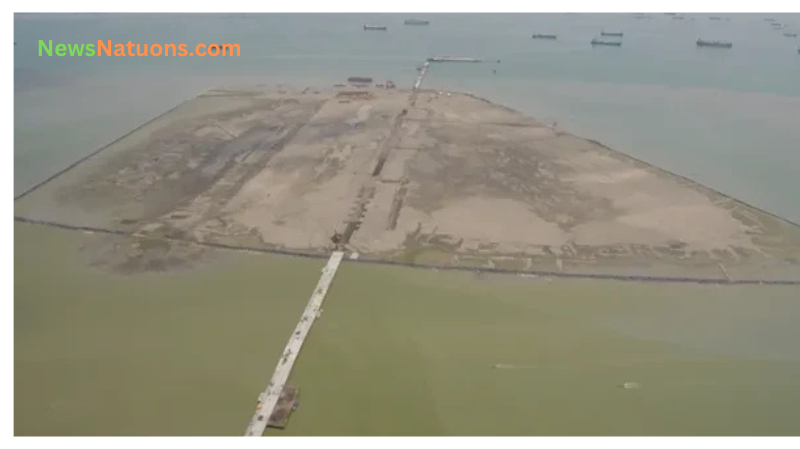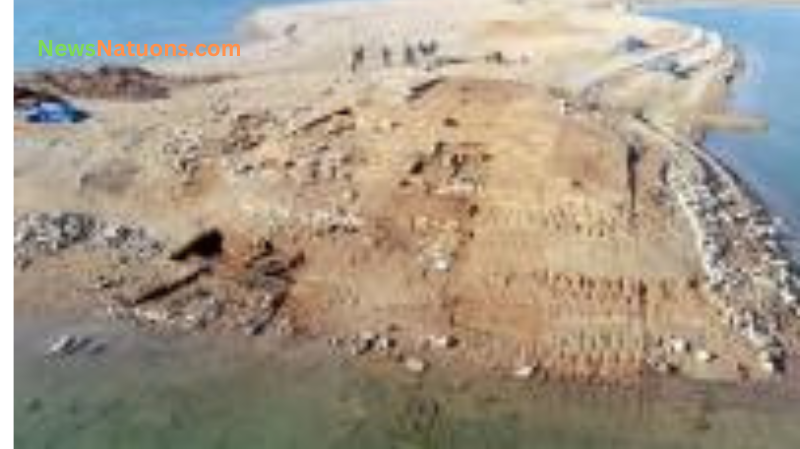A groundbreaking discovery off the coast of Indonesia has the potential to rewrite human history. Scientists have unearthed what could be the remnants of an ancient, possibly lost civilization buried beneath the seabed between the islands of Java and Madura. This astonishing find includes a 140,000-year-old human skull and thousands of animal fossils, offering a rare glimpse into a world that existed long before written history.
An Ancient Skull Buried Beneath the Sea
The discovery was made in the Madura Strait, a narrow body of water separating Java and Madura islands. Researchers found a fossilized human skull that dates back approximately 140,000 years. This find is significant, not just for its age but also for its location—buried deep in the sand under the sea. According to scientists, this region may be the first physical proof of a long-lost prehistoric land known as Sundaland.
Sundaland was a vast landmass that once connected parts of Southeast Asia, including modern-day Indonesia, Malaysia, and Thailand. It was believed to have existed before the rise in sea levels submerged it under the ocean. The discovery of this skull offers new insights into how early humans lived and migrated in this region.
Fossils of Animals and Signs of Early Hunting
Along with the human skull, researchers found over 6,000 fossils from 36 different species. These include remains of Komodo dragons, deer, elephants, and wild buffalo. What’s especially fascinating is that some of these bones had cut marks on them, suggesting that early humans used tools to hunt and process animals. These marks provide concrete evidence of advanced hunting techniques being used as far back as 140,000 years ago.
This collection of fossils was originally discovered by maritime sand miners in 2011. However, it was only recently that experts were able to accurately date the fossils and determine the species. This has now become a milestone in the field of paleoanthropology, the scientific study of ancient humans and their environment.
A Submerged River System Hidden Below
The scientists also explored what appears to be a buried river valley system beneath the sea. This hidden river network, believed to be a part of the ancient Solo River system, lies beneath layers of marine sand and sediment. It is within this system that the fossils and skull were found.
Advanced dating techniques have helped experts estimate the age of this hidden landscape to be between 119,000 and 162,000 years old. These findings suggest that this area was once a rich, habitable zone for early humans and animals, long before it was swallowed by the sea.
Changing Our Understanding of Prehistoric Human Life
This discovery challenges many previously held beliefs about the movement and evolution of early humans in Southeast Asia. The fossilized skull and animal remains indicate that ancient human communities may have settled and thrived in this region much earlier than previously thought.
Moreover, the complexity of the tools and the marks on the bones imply that these early humans were not merely primitive beings but had already developed sophisticated survival strategies. It raises questions about the existence of now-lost civilizations that could have lived in harmony with nature and developed rudimentary technologies far ahead of their time.
A Landmark in Scientific Research
This finding is not just significant for historians or archaeologists; it holds deep implications for understanding climate change and geological transformations over millennia. The fact that such an advanced ecosystem once existed where now only seawater flows reminds us of how dynamic Earth’s surface has been.
For scientists, the submerged river valleys and the diverse fossil collection offer valuable information about migration patterns, climate shifts, and evolutionary biology. For the world, it paints a vivid picture of a hidden chapter in our shared human past.
انڈونیشیا کے ساحل کے نیچے ایک ایسی شاندار دریافت سامنے آئی ہے جو ممکنہ طور پر انسانی تاریخ کو بدل سکتی ہے۔ سائنس دانوں نے جاوا اور مدورا کے جزیروں کے درمیان مدورا اسٹریٹ میں ایک قدیم انسانی کھوپڑی دریافت کی ہے جو تقریباً 1 لاکھ 40 ہزار سال پرانی ہے۔ اس کے ساتھ ہزاروں جانوروں کے فاسل بھی ملے ہیں، جو اس دور کی زندگی کے بارے میں حیرت انگیز معلومات فراہم کرتے ہیں۔
سمندر کے نیچے دفن قدیم انسانی کھوپڑی
یہ دریافت مدورا اسٹریٹ کے ساحلی علاقے میں ہوئی، جو جاوا اور مدورا جزیروں کو جدا کرتا ہے۔ یہاں سائنس دانوں کو ایک انسانی کھوپڑی ملی جو اندازاً 1 لاکھ 40 ہزار سال پرانی ہے۔ اس دریافت کی خاص بات اس کی جگہ ہے—یہ کھوپڑی سمندر کی ریت میں گہری دفن تھی۔
ماہرین کا کہنا ہے کہ یہ مقام شاید سنڈا لینڈ نامی گمشدہ دنیا کا پہلا طبعی ثبوت ہے۔ سنڈا لینڈ ایک وسیع زمینی خطہ تھا جو جنوبی مشرقی ایشیا کے موجودہ علاقوں جیسے انڈونیشیا، ملائیشیا اور تھائی لینڈ کو آپس میں جوڑتا تھا۔ سمندر کے پانیوں کے نیچے دب جانے سے پہلے یہ خطہ زمین کا حصہ تھا۔
جانوروں کے فاسلز اور قدیم شکار کے شواہد
انسانی کھوپڑی کے ساتھ 36 اقسام کے جانوروں کے 6000 سے زیادہ فاسل بھی دریافت ہوئے۔ ان میں کوموڈو ڈریگن، بھینسے، ہرن اور ہاتھی شامل ہیں۔ کچھ ہڈیوں پر واضح کٹ کے نشانات موجود ہیں، جو اس بات کا ثبوت ہیں کہ ابتدائی انسان جانوروں کے شکار اور گوشت نکالنے کے لیے آلات استعمال کرتے تھے۔
یہ فاسلز دراصل 2011 میں میری ٹائم سینڈ مائنرز نے دریافت کیے تھے، لیکن ان کی درست عمر اور انواع کا تعین حال ہی میں ممکن ہوا ہے۔ یہ تحقیق پیلیو اینتھروپولوجی یعنی قدیم انسانی ارتقا کے مطالعے کے میدان میں ایک اہم کامیابی سمجھی جا رہی ہے۔
سمندر کے نیچے چھپی ہوئی دریا کی وادی

تحقیق کے دوران سائنس دانوں نے ایک مدفون دریا کے نظام کا بھی سراغ لگایا۔ یہ نظام غالباً قدیم سولو دریا کا حصہ تھا، جو اب سمندری ریت اور تہوں کے نیچے چھپا ہوا ہے۔ یہی وہ جگہ ہے جہاں سے یہ باقیات ملی ہیں۔
ماہرین نے جدید تکنیکی طریقوں سے اس زیرِ زمین وادی کی عمر کا اندازہ لگایا جو 1 لاکھ 19 ہزار سے 1 لاکھ 62 ہزار سال کے درمیان ہے۔ یہ ثابت کرتا ہے کہ کبھی یہ علاقہ ایک زرخیز اور انسانی زندگی کے لیے موزوں خطہ تھا جو بعد میں سمندر کی تہ میں چلا گیا۔
انسان کی قدیم زندگی کے بارے میں نئی سمجھ بوجھ
یہ دریافت ان نظریات کو چیلنج کرتی ہے جو جنوبی ایشیا میں انسانوں کی آمد اور ارتقا سے متعلق پہلے سے قائم تھے۔ کھوپڑی اور جانوروں کی باقیات سے ظاہر ہوتا ہے کہ انسان اس خطے میں اس سے کہیں پہلے آباد تھے جتنا ہم اب تک سمجھتے آئے ہیں۔
اس کے ساتھ ساتھ، ہڈیوں پر موجود کٹ کے نشانات اس بات کی گواہی دیتے ہیں کہ یہ لوگ محض وحشی یا غیر ترقی یافتہ نہیں تھے، بلکہ وہ جدید انداز میں شکار کرتے اور آلات استعمال کرتے تھے۔ یہ دریافت ان گمشدہ تہذیبوں کے وجود کا امکان پیدا کرتی ہے جو اپنے وقت سے کہیں آگے کی ٹیکنالوجی استعمال کرتی تھیں۔
سائنسی تحقیق میں ایک اہم سنگِ میل
یہ دریافت صرف مورخین یا آثارِ قدیمہ کے ماہرین کے لیے نہیں بلکہ موسمیاتی تبدیلیوں اور زمینی ارتقائی عمل کو سمجھنے کے لیے بھی اہم ہے۔ اس سے یہ پیغام ملتا ہے کہ ہماری زمین مسلسل تبدیلی کے عمل سے گزرتی رہی ہے۔
سائنس دانوں کے لیے یہ دریا کی وادی اور فوسلز نہ صرف قدیم انسانوں کی ہجرت بلکہ ماحولیاتی تبدیلیوں اور ارتقائی حیاتیات کے مطالعے کے لیے بھی بے حد قیمتی ہیں۔ دنیا کے لیے یہ دریافت انسانی تاریخ کے ایک چھپے ہوئے باب کو روشن کرتی ہے۔











